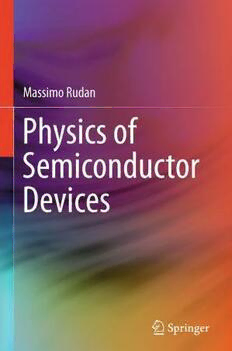Table Of Content
Physics of Semiconductor Devices
Massimo Rudan
Physics of Semiconductor
Devices
2123
MassimoRudan
UniversityofBologna
Bologna
Italy
ISBN978-1-4939-1150-9 ISBN978-1-4939-1151-6(eBook)
DOI10.1007/978-1-4939-1151-6
SpringerNewYorkHeidelbergDordrechtLondon
LibraryofCongressControlNumber:2014953969
© SpringerScience+BusinessMediaNewYork2015
Thisworkissubjecttocopyright.AllrightsarereservedbythePublisher,whetherthewholeorpartofthe
materialisconcerned,specificallytherightsoftranslation,reprinting,reuseofillustrations,recitation,
broadcasting,reproductiononmicrofilmsorinanyotherphysicalway,andtransmissionorinformation
storageandretrieval,electronicadaptation,computersoftware,orbysimilarordissimilarmethodology
nowknownorhereafterdeveloped.Exemptedfromthislegalreservationarebriefexcerptsinconnection
withreviewsorscholarlyanalysisormaterialsuppliedspecificallyforthepurposeofbeingenteredand
executed on a computer system, for exclusive use by the purchaser of the work. Duplication of this
publicationorpartsthereofispermittedonlyundertheprovisionsoftheCopyrightLawofthePublisher’s
location,initscurrentversion,andpermissionforusemustalwaysbeobtainedfromSpringer.Permissions
forusemaybeobtainedthroughRightsLinkattheCopyrightClearanceCenter.Violationsareliableto
prosecutionundertherespectiveCopyrightLaw.
Theuseofgeneraldescriptivenames,registerednames,trademarks,servicemarks,etc.inthispublication
doesnotimply,evenintheabsenceofaspecificstatement,thatsuchnamesareexemptfromtherelevant
protectivelawsandregulationsandthereforefreeforgeneraluse.
Whiletheadviceandinformationinthisbookarebelievedtobetrueandaccurateatthedateofpublication,
neithertheauthorsnortheeditorsnorthepublishercanacceptanylegalresponsibilityforanyerrorsor
omissionsthatmaybemade.Thepublishermakesnowarranty,expressorimplied,withrespecttothe
materialcontainedherein.
Printedonacid-freepaper
SpringerispartofSpringerScience+BusinessMedia(www.springer.com)
ToRossellaandMorgana
Preface
ThisvolumeoriginatesfromthelecturesonSolid-StateElectronicsandMicroelec-
tronics that I have been giving since 1978 at the School of Engineering of the
University of Bologna. Its scope is to provide the reader with a book that, start-
ing from the elementary principles of classical mechanics and electromagnetism,
introducestheconceptsofquantummechanicsandsolid-statetheory,anddescribes
the basic physics of semiconductors including the hierarchy of transport models,
endingupwiththestandardmathematicalmodelofsemiconductordevicesandthe
analysis of the behavior of basic devices. The ambition of the work has been to
writeabook,selfcontainedasfaraspossible,thatwouldbeusefulforbothstudents
and researchers; to this purpose, a strong effort has been made to elucidate phys-
ical concepts, mathematical derivations, and approximation levels, without being
verbose.
Thebookisdividedintoeightparts. PartIdealswithanalyticalmechanicsand
electromagnetism; purposedly, the material is not given in the form of a resumé:
quantum-mechanicsandsolid-statetheory’sconceptsaresorichlyintertwinedwith
theclassicalonesthatpresentingthelatterinanabridgedformmaymaketheread-
ing unwieldy and the connections more difficult to establish. Part II provides the
introductory concepts of statistical mechanics and quantum mechanics, followed
by the description of the general methods of quantum mechanics. The problem of
bridgingtheclassicalconceptswiththequantumonesisfirsttackledusingthehis-
torical perspective, covering the years from 1900 to 1926. The type of statistical
description necessary for describing the experiments, and the connection with the
limiting case of the same experiments involving massive bodies, is related to the
propertiesofthedoubly-stochasticmatrices.PartIIIillustratesanumberofapplica-
tionsoftheSchrödingerequation:elementarycases,solutionsbyfactorization,and
time-dependent perturbation theory. Part IV analyzes the properties of systems of
particles,withspecialattentiontothosemadeofidenticalparticles,andthemethods
forseparatingtheequations.TheconceptsaboveareappliedinPartVtotheanalysis
ofperiodicstructures, withemphasistocrystalsofthecubictypeandtosiliconin
particular,which,sincethelate1960s,hasbeenandstillisthemostimportantma-
terialforthefabricationofintegratedcircuits.PartVIillustratesthesingle-electron
dynamicsinaperiodicstructureandderivesthesemiclassicalBoltzmannTransport
vii
viii Preface
Equation;fromthelatter,thehydrodynamicanddrift-diffusionmodelsofsemicon-
ductordevicesareobtainedusingthemomentsexpansion.Thedrift-diffusionmodel
isusedinPartVIItoworkoutanalyticallytheelectricalcharacteristicsfortheba-
sicdevicesofthebipolarandMOStype.Finally,PartVIIIpresentsacollectionof
itemswhich,althoughimportantperse,arenotinthebook’smainstream:someof
the fabrication-process steps of integrated circuits (thermal diffusion, thermal ox-
idation, layer deposition, epitaxy), and methods for measuring the semiconductor
parameters.
In the preparation of the book I have been helped by many colleagues. I wish
to thank, in particular, Giorgio Baccarani, Carlo Jacoboni, and Rossella Brunetti,
whogavemeimportantsuggestionsaboutthematter’sdistributioninthebook,read
the manuscript and, with their observations, helped me to clarify and improve the
text;Iwishalsotothank,forreadingthemanuscriptandgivingmetheircomments,
Giovanni Betti Beneventi, Fabrizio Buscemi, Gaetano D’Emma, Antonio Gnudi,
ElenaGnani,EnricoPiccinini,SusannaReggiani,PaoloSpadini.
Last, but not least, I wish to thank the students, undergraduate, graduate, and
postdocs,whofordecadeshaveaccompaniedmyteachingandresearchactivitywith
stimulatingcuriosity.Manycomments,exercises,andcomplementsofthisbookare
thedirectresultofquestionsandcommentsthatcamefromthem.
Bologna MassimoRudan
September2014
Contents
PartI AReviewofAnalyticalMechanicsandElectromagnetism
1 AnalyticalMechanics .......................................... 3
1.1 Introduction ............................................ 3
1.2 VariationalCalculus...................................... 4
1.3 LagrangianFunction ..................................... 6
1.3.1 ForceDerivingfromaPotentialEnergy ............. 7
1.3.2 ElectromagneticForce............................ 7
1.3.3 Work .......................................... 9
1.3.4 HamiltonPrinciple—SynchronousTrajectories ....... 10
1.4 GeneralizedCoordinates .................................. 10
1.5 HamiltonianFunction .................................... 12
1.6 HamiltonEquations ...................................... 13
1.7 Time–EnergyConjugacy—Hamilton–JacobiEquation ......... 15
1.8 PoissonBrackets ........................................ 17
1.9 PhaseSpaceandStateSpace .............................. 18
1.10 Complements ........................................... 19
1.10.1 Higher-OrderVariationalCalculus.................. 19
1.10.2 LagrangianInvarianceandGaugeInvariance ......... 20
1.10.3 VariationalCalculuswithConstraints ............... 20
1.10.4 AnInterestingExampleofExtremumEquation ....... 21
1.10.5 Constant-EnergySurfaces......................... 23
Problems ..................................................... 23
2 CoordinateTransformationsandInvarianceProperties ........... 25
2.1 Introduction ............................................ 25
2.2 CanonicalTransformations ................................ 26
2.3 AnApplicationoftheCanonicalTransformation .............. 29
2.4 Separation—Hamilton’sCharacteristicFunction .............. 30
2.5 PhaseVelocity .......................................... 31
2.6 InvarianceProperties ..................................... 32
2.6.1 TimeReversal................................... 32
2.6.2 TranslationofTime .............................. 33
ix
x Contents
2.6.3 TranslationoftheCoordinates ..................... 33
2.6.4 RotationoftheCoordinates........................ 34
2.7 MaupertuisPrinciple ..................................... 35
2.8 SphericalCoordinates—AngularMomentum................. 36
2.9 LinearMotion........................................... 38
2.10 Action-AngleVariables ................................... 39
2.11 Complements ........................................... 41
2.11.1 InfinitesimalCanonicalTransformations............. 41
2.11.2 ConstantsofMotion.............................. 41
Problems ..................................................... 42
3 ApplicationsoftheConceptsofAnalyticalMechanics ............. 43
3.1 Introduction ............................................ 43
3.2 ParticleinaSquareWell .................................. 43
3.3 LinearHarmonicOscillator................................ 44
3.4 CentralMotion .......................................... 45
3.5 Two-ParticleCollision.................................... 47
3.6 EnergyExchangeintheTwo-ParticleCollision ............... 49
3.7 CentralMotionintheTwo-ParticleInteraction................ 51
3.8 CoulombField .......................................... 52
3.9 SystemofParticlesnearanEquilibriumPoint ................ 53
3.10 DiagonalizationoftheHamiltonianFunction................. 55
3.11 PeriodicPotentialEnergy ................................. 57
3.12 Energy-MomentumRelationinaPeriodicPotentialEnergy..... 60
3.13 Complements ........................................... 61
3.13.1 CommentsontheLinearHarmonicOscillator ........ 61
3.13.2 DegreesofFreedomandCoordinateSeparation....... 61
3.13.3 CommentsontheNormalCoordinates .............. 62
3.13.4 ArealVelocityintheCentral-MotionProblem ........ 63
3.13.5 InitialConditionsintheCentral-MotionProblem ..... 64
3.13.6 TheCoulombFieldintheAttractiveCase............ 65
3.13.7 DynamicRelationsofSpecialRelativity............. 67
3.13.8 CollisionofRelativisticParticles ................... 68
3.13.9 EnergyConservationinCharged-Particles’Interaction . 70
Problems ..................................................... 70
4 Electromagnetism............................................. 71
4.1 Introduction ............................................ 71
4.2 ExtensionoftheLagrangianFormalism ..................... 71
4.3 LagrangianFunctionfortheWaveEquation.................. 74
4.4 MaxwellEquations ...................................... 75
4.5 PotentialsandGaugeTransformations ...................... 77
4.6 LagrangianDensityfortheMaxwellEquations ............... 79
4.7 HelmholtzEquation...................................... 80
4.8 HelmholtzEquationinaFiniteDomain ..................... 81
Contents xi
4.9 SolutionoftheHelmholtzEquationinanInfiniteDomain ...... 82
4.10 SolutionoftheWaveEquationinanInfiniteDomain .......... 83
4.11 LorentzForce ........................................... 84
4.12 Complements ........................................... 85
4.12.1 InvarianceoftheEulerEquations................... 85
4.12.2 WaveEquationsfortheEandBFields .............. 85
4.12.3 CommentsontheBoundary-ValueProblem .......... 86
Problems ..................................................... 86
5 ApplicationsoftheConceptsofElectromagnetism ................ 87
5.1 Introduction ............................................ 87
5.2 PotentialsGeneratedbyaPoint-LikeCharge ................. 87
5.3 EnergyContinuity—PoyntingVector........................ 89
5.4 MomentumContinuity ................................... 90
5.5 ModesoftheElectromagneticField ........................ 91
5.6 EnergyoftheElectromagneticFieldinTermsofModes........ 93
5.7 MomentumoftheElectromagneticFieldinTermsofModes.... 95
5.8 ModesoftheElectromagneticFieldinanInfiniteDomain...... 96
5.9 EikonalEquation ........................................ 97
5.10 FermatPrinciple......................................... 99
5.11 Complements ........................................... 99
5.11.1 FieldsGeneratedbyaPoint-LikeCharge ............ 99
5.11.2 PowerRadiatedbyaPoint-LikeCharge ............. 101
5.11.3 DecayofAtomsAccordingtotheClassicalModel .... 102
5.11.4 CommentsabouttheField’sExpansionintoModes.... 104
5.11.5 FinitenessoftheTotalEnergy...................... 105
5.11.6 Analogiesbetween Mechanicsand GeometricalOptics 106
Problems ..................................................... 107
PartII IntroductoryConceptstoStatisticalandQuantumMechanics
6 ClassicalDistributionFunctionandTransportEquation........... 111
6.1 Introduction ............................................ 111
6.2 DistributionFunction..................................... 111
6.3 StatisticalEquilibrium.................................... 113
6.4 Maxwell-BoltzmannDistribution........................... 116
6.5 BoltzmannTransportEquation............................. 119
6.6 Complements ........................................... 120
6.6.1 MomentumandAngularMomentumatEquilibrium ... 120
6.6.2 AveragesBasedontheMaxwell-BoltzmannDistribution 121
6.6.3 Boltzmann’sH-Theorem.......................... 123
6.6.4 Paradoxes—Kac-RingModel..................... 124
6.6.5 EquilibriumLimitoftheBoltzmannTransportEquation 125
Problems ..................................................... 127

